Imagine the scenario of
tertiary care medical practice in the 1980s in India. There was no boom
of endoscopic surgeries, magnetic resonance imaging was unheard of, and
super-specialization care was sporadic, even at tertiary care centers.
Can we imagine medical practice at tertiary care level now, without
these facilities? Diagnostic and treatment modalities even at primary
and secondary care levels have reformed a lot. Medical science is a
dynamic field; newer techniques are added every day, treatment protocols
are updated regularly, reference diagnostic values change over a period
of time. What was a good treatment protocol for hypertension in Joint
National Committee-7 (JNC-7) recommendations may not hold good after
JNC-8 report [1]. A person categorized as diabetic now, as per current
reference range, may not had been marked as diabetic during last
century. This dynamic nature of medical sciences mandates its ‘students
to be learner for the whole of their life’ so as to remain ‘current’ in
their knowledge and skills.
Though the trend of continuous medical education
(CME) is picking up fast in India, particularly after State Medical
Councils making it a mandatory criteria to earn specific credit hours
for renewal of medical registration [2]; voluntarily participation for
the whole session of the CME activity barely happens, thus making the
whole exercise a futile effort.
This lacklustre attitude makes it imperative to
conceptualize, and cultivate lifelong learning skills in medical
graduates during training. Medical Council of India (MCI) too has
emphasized the need for medical graduate to be lifelong learners by
incorporating this as one of the five competencies for the Indian
Medical Graduate (IMG), in its 2012 regulations on graduate medical
education [3]. As per the guidelines, IMG must acquire certain
sub-competencies during graduation to be a competent lifelong learner (Box
1). Similarly, other medical boards have also stressed on
lifelong learning [4].
|
Box 1 Sub-competencies for the Core
Competency of Lifelong-learner as per MCI Guidelines
An Indian Medical Graduate, at the time of
graduation must demonstrate ability to:
• Do an objective self-assessment of
knowledge and skills.
• Continue learning, improve existing skills
and attain new skills.
• Search and critically appraise medical
literature.
• Utilize experiences, to improve personal
and professional growth and learning.
• Apply the newly gained knowledge and skills in patient
care.
|
What is Lifelong Learning?
The term lifelong learning initially featured in 1973
in the report of the International Commission on the Development of
Education, a UNESCO body, linking-up lifelong learning with the idea of
the learning society [5]. Subsequently, lifelong learning was recognized
as a "continuous, constant, unending, lifetime quest, which starts with
birth and concludes only at death" [6]. More recently, lifelong learning
has been defined as a "learning that is carried for the entire life, is
flexible, varied and accessible at all the times and in different
places" [7].
The European Lifelong Learning Initiative defines it
as "a continuously supportive process which stimulates and
empowers individuals to acquire all the knowledge, values, skills and
understanding they will require throughout their lifetimes and to apply
them with confidence, creativity and enjoyment, in all roles,
circumstances, and environments" [8]. Commission of the European
Communities defined it as "all learning activity undertaken throughout
life, with the aim of improving knowledge, skills and competences within
a personal, civic, social and/or employment-related perspective" [9].
The National Agency for Education of Sweden
introduced the model of life-wide learning along with lifelong learning.
Life-wide learning has been recognized as learning that incorporates
learning from all the dimensions of life - the formal, non-formal and
informal settings [10]. Lifelong learning has also been termed as
‘joined-up education’ - a strategy to learning which recognizes and
thoroughly eradicates detrimental discontinuities between different
phases and settings for learning with its holistic outlook [11]. The
process of lifelong learning is based on four pillars of education for
the future - learning to know; learning to do; learning to live together
with others; and learning to be (human)[12].
Characteristics of Lifelong Learning
Formal and informal education: Lifelong
learning, most typically, involves both formal and informal education.
Formal education occurs through traditional schools, colleges,
universities and other higher educational institutes and results in
certification; while informal learning can happen at workplace, home,
club, organization etc through peers, family members, colleagues, media
etc [13].
Life-wide learning: This dimension of lifelong
learning is more complex. It not only identifies a range of settings
resulting in lifelong learning like formal and informal, but also
embraces different contexts at a given point of time during learning
[8].
Self-motivated learning: This attribute involves
two very important aspects – self directed learning and motivation.
Lifelong learning is inevitably self-learning. Motivation and lifelong
learning are in fact two inseparable constructs – a lifelong learner is
always a motivated individual and motivated individual can be a lifelong
learner [14].
Introspection and self-assessment: While doing
self-assessment, students appraise the standards of their own work and
learning, evaluate and scale the extent to which they have been able to
achieve the learning goals, reflect on the strengths of their learning
and learning gaps, and look for opportunities of improvement accordingly
[15].
Interaction and fusion: Specific learning
interactions and collaborative learning are valuable characteristics of
lifelong learning environments. Interactions can be in family, with
peers, at workplace, in social gatherings. These learning environments
provide opportunities not only for discussing expectations but also
providing feedback.
Application of knowledge and skills: Knowledge
and skills gained without their application do not benefit self and
others. Learning should always translate in to application. It not only
promotes further interest and motivates the participants, but also
raises more queries and desires to learn more.
Holistic approach and universal participation:
The Organization for Economic Co-operation and Development has linked-up
the universal involvement for learning with the financial demands of the
21st century. This model of universal involvement consists of learning
for all purposes - learning for self improvement and understanding,
learning for social reasons, and learning for economic well-being [16].
Benefits and Attributes of Lifelong Learner
The top ten benefits of lifelong learning are listed
in Box 2 [17]. Two skills which are helpful in achieving
the competence of lifelong learning are – metacognition and
self-directed learning. Metacognitive skills refers to taking
responsibility and ownership of self learning, making strategies for
learning and choose appropriate strategies, scrutinizing the growth of
learning, taking corrective measures, evaluating the efficacy of
learning strategies, and shifting to other learning strategies, whenever
required [18]. As metacognition engrosses self-dictatorial and
self-controlling skills, it is said to have a constructive influence on
problem-solving aptitude and lifelong learning, if developed during
training. If not developed, students are stated to have faced problems
in identifying learning gaps [19]. As stated earlier, self-directed
learning skills are the cornerstone of being a lifelong learner.
|
Box 2 Benefits of Lifelong-learning
|
|
• Assists to sharpen natural talent
• Unlocks the intellect
• Builds an inquisitive, curious mind
• Enhance intelligence
• Makes the world a superior place
• Helps us espouse to adjust
• Helps in finding sense in life
• Keep us occupied as energetic member of the
society
• Helps us make new friends and start new
associations
• Lifelong learning leads to an enriching life of self
fulfillment
|
Other two very important attributes of lifelong
learner are – self-monitoring and reflective behavior. Students should
be skilled enough to monitor their own progress and identify the
learning gaps and look for improvements. Any understanding of learning
that is lifelong and life-wide requires critical analysis of the
learning; thus reinforcing the need to develop reflective behavior for
lifelong learning [20]. Thus a learner having metacognitive skills, who
is self-directed learner, monitors own learning progress, and possesses
reflective attitude is more likely to be a lifelong learner (Fig.
1).
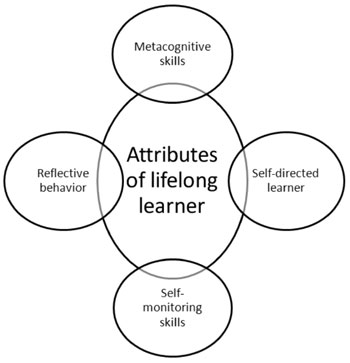 |
|
Fig. 1 Attributes of a lifelong
learner.
|
Strategies for Cultivating Lifelong Learning
The core competency of lifelong learning can be very
well imbibed by the medical graduates if a holistic strategy which can
target the three most important characteristics of lifelong learning –
self-motivated learning, self-assessment, and application of knowledge
and skills; along with training on time-management, is in place. These
strategies should be designed to utilise the existing teaching-learning
tools, optimally.
Identify individual learning styles: For lifelong
learning behaviors to be cultivated, due consideration must be given to
identifying learning styles and multiple intelligences of the
participating students. Processing of information, retention, and recall
are all directly related to the learning style of the individual. It
must be considered that students learn through various styles - by
personal meaning, by conceptual learning, by knowing how things work,
and by self-discovery. Similarly, students have different levels of
intelligence in different areas like: verbal-linguistic, musical,
logic-mathematical, spatial, kinesthetic, interpersonal, intrapersonal,
and naturalistic [21]. The role of identifying intelligence area in
lifelong learning success has previously been well established in
psychological studies [22]. VARK (visual, aural, read/written,
kinesthetic) questionnaire, with many available versions can be used to
identify learning styles and multi-modal intelligence in learners. The
version suiting a particular learning environment can be easily picked
for use [23].
Set learning goals: Setting learning goals and
attaining them can help with self-assessment and cultivation of lifelong
learning behaviors. Development of learning goals may necessitate the
analysis of many resource materials and compilation and scrutiny of
information from many diverse sources [24]. Targeting interventions to
develop characteristics associated with greater progress toward
achieving learning goals may assist in developing lifelong learning.
Learner confidence in developing and attaining learning goals can be
improved through education on the creation and use of learning goals
[25]. Reed, et al. [26] found that an explicit orientation to
learning goals helps learners set goals, and reinforces the importance
of lifelong learning.
Adopting reinforcing teaching-learning methods:
Medical undergraduates already have prior learning experiences.
Acknowledging their understanding and experiences and using appropriate
instructional strategy accordingly, help in cultivating lifelong
learning behaviors. Educational and instructional strategies which
incorporate the concepts of self-directed learning are the mainstay for
reinforcement of lifelong learning. These instructional strategies are
described in the next section.
Application: Graduates are motivated by favorable
learning outcomes and always like to ascertain the role of the learning
activity in achieving their learning goals. If the learning is relevant
to their working environments, they are more likely to learn, and learn
it for lifelong. Adults always want learning that is practical in
pragmatic, real life scenarios [27]. For cultivating lifelong learning
in medical graduates, there should be contextual match between the
instructional strategies, learning goals, and their applicability in
real life situations. The concept of applicability can be reinforced
during graduate training by imparting more of hands-on training in
simulated-environments, case-based scenarios and during
clinical-postings.
Time-management: Graduates must be trained to
prioritize their time and utilize it in the best possible way.
Instructional Methodologies For Cultivating Lifelong
Learning Skills
Keeping track of newer advances, diagnostic
techniques, treatment protocols, and information on updated
reference-ranges is a precondition for making successful and immediate
diagnostic and treatment decisions [28]. Instructional strategies that
profess to foster lifelong learning behaviors by involving students in
self-directed, self-assessed, problem-oriented learning experiences are
outlined in Fig. 2.
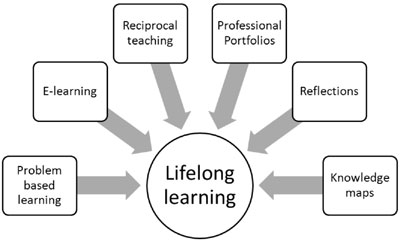 |
|
Fig. 2 Instructional methodologies for
cultivating and promoting lifelong learning skills.
|
Problem-based Learning
Learning is centered on a well-designed clinical
problem through which students identify their learning requirements,
make an enquiry, and correlate the theory and the practice [29]. PBL is
an educational cycle (running through 4 phases) that develops students’
lifelong learning skills because of their active participation Fig.
3.
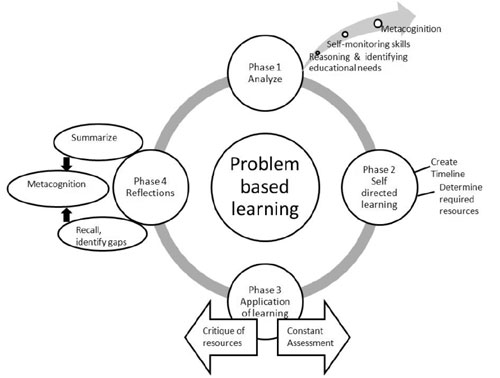 |
|
Fig. 3 Cultivating lifelong learning
skills through Problem -based learning educational cycle.
|
• During Phase 1 (analyzing) students look
through the presented problem, reasoning gaps, identify educational
needs, formulate hypotheses, critically evaluate the comments of
fellow students, and lay down learning goals and create strategies
to achieve those targeted goals. Through such strategies,
self-monitoring skills of students and thinking attitude, the
essentials for being metacognitive, are improved.
• In Phase 2 (self-directed learning) students
draft a timeline, determine required resources and execute
strategies for learning by self-study; thus building upon the
critical component of lifelong learning – self-directed and
motivated learning.
• In Phase 3 (application) students correlate the
learning to the problem and analyze the information sources and
their personal research methods used during self-directed learning
phase. This constant assessment of learning resources and personal
methods help to develop lifelong learning skills.
• During Phase 4 (reflections) students
recapitulate and share the knowledge gained and converse to apply
that to solve problems faced in future. They constantly reflect on
the educational experience they gained, and try to integrate new
learning into their existing knowledge structures, thus improving
the metacognitive skills required for lifelong learning [29].
PBL as an instructional strategy should be
introduced to the students during initial days of undergraduate medical
training itself. Foundation course, as stipulated in new MCI guidelines
will be the ideal time to sensitize and expose students to self-directed
learning and PBL. Early clinical exposure will provide another
opportunity to reinforce PBL concepts, thus helping to adopt it in
routine medical graduate training during subsequent years and cultivate
lifelong learning skills.
E-learning
E-learning (electronic learning) includes all
teaching-learning activities pursued by individuals or groups,
functioning online or offline, synchronously or asynchronously through
the use of computers and other electronic devices. E-learning is usually
considered synonymous with web-based learning, online learning, internet
based learning, computer aided learning, and mobile learning. It is more
flexible and the learners, to a limit, are accountable for deciding the
pace of their own learning.
These inherent qualities of e-learning coupled with
e-assessment help to inculcate self-motivated learning, give chance of
self assessment, reflection and determining learning gaps and promote
lifelong learning. E-learning is the teaching-learning tool now being
used widely for lifelong learning outside the boundaries of traditional
and certified learning too [30].
Ram, et al. [31] have explicitly detailed the
methods of introducing PBL through e-learning methods, thereby further
opening the opportunities for lifelong learning during traditional
teaching years as well as after finishing schooling.
As MCI has made it mandatory for every medical
college to install facilities of virtual classrooms; e-learning will be
a norm rather than exception in Indian medical training program. Faculty
should start delivering a part of the curriculum at least through
e-learning, thus guiding the students to use this self-study mode more
frequently.
Reciprocal Teaching
Palincsar and Klenk [32] described reciprocal
teaching as – "an instructional procedure that takes place in a
collaborative learning group and features guided practice in the
flexible application of four concrete strategies to the task of text
comprehension: questioning, summarizing, clarifying, and predicting. The
teacher and group of students take turns leading discussions regarding
the content of the text they are jointly attempting to understand."
It is an example of teacher-led collaborative
instructional structure with role-reversal – student act as teacher too.
Typically, reciprocal teaching runs in two phases – in first phase
teacher models presents the comprehension skills by articulating
questions and summary that are associated with problem/excerpt detailed
in the class and in next phase student act like model and deals with
another problem in the same way the teacher model has done earlier. As
reciprocal teaching promotes reading and comprehensive skills coupled
with promoting enquiry, immediate feedback, critique skills; in a way it
promotes inculcating of metacognition and self-directed learning with
self-monitoring and thus promotes lifelong learning skills (Fig.
4).
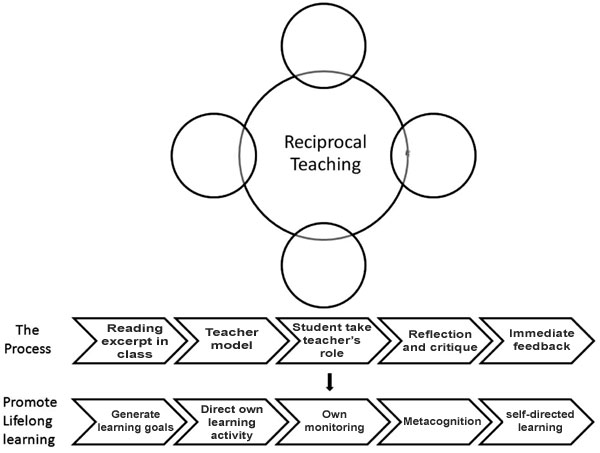 |
|
Fig. 4: Cultivating lifelong learning
skills through reciprocal teaching environments.
|
Reciprocal teaching strategies can be adopted in
graduate medical training by way of small group discussion, tutorials,
and students’ integrated seminars.
Portfolios
The role of portfolios in medical eduction has also
been discussed before [33]. A portfolio is a systematic and
well-designed collection of the learner’s work. Portfolio continues to
grow with the academic/professional growth of the learner and depicts
the account of learner’s academic achievements, development, and
progress over time. Portfolios can be used to cultivate lifelong
learning skills by promoting self-learning [34]. Additionally, by using
portfolios, students can improve their responsive-ness towards their own
learning, and thus help to inculcate the attitude of self-improvement.
Also self-motivated learning improves with critique on one’s
achievements and learning gaps, which are integral to the portfolios
[33]. Portfolios also help to promote collaborative learning, and
supports self-assessment behaviors [35]. These inherent qualities of
portfolios help cultivating lifelong learning skills.
Though, it is not possible to design a portfolio for
entire undergraduate medical training, but internship is the ideal time
when medical students should be trained and encouraged to maintain a
portfolio of their work, learning and training. Even otherwise, logbooks
are maintained by interns, in one or the other form; and these logbooks
can easily be replaced with portfolios, thus helping to inculcate
lifelong learning skills.
Reflections
Reflection is described as – "a cycle of paying
deliberate, systematic and analytical attention to one’s own thoughts
and actions, feelings, thinking and in relation to particular
experiences for the purpose of enhancing perceptions of and responses to
current and future experiences’’ [36]. Regardless of the definition,
reflection is critical thinking during the process of learning or after
the process is over by linking new learning experiences and ideas to
prior experiences in order to develop more complex concepts, and thus
promoting higher order thinking. Reflection helps students to share more
responsibility of their learning, which in turn can promote ‘reflective
practice’ during professional life later on, and can help in promoting
lifelong learning skills (Fig. 5).
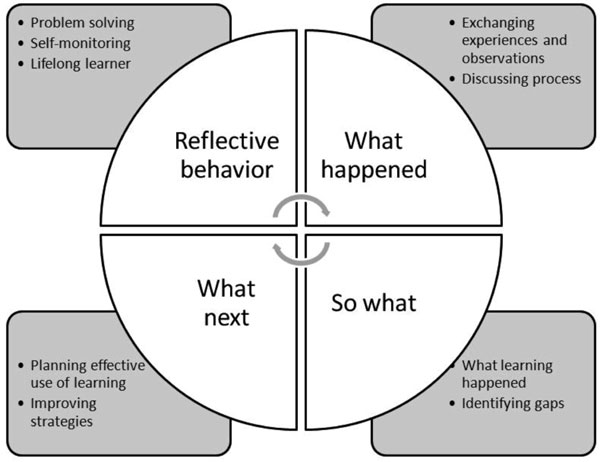 |
|
Fig. 5 Cultivating critical reflective
attitude for lifelong learning skills.
|
Reflective learning is a critical component of PBL,
reciprocal teaching, and learning through portfolios. At the same time
one can reflect on any other independent learning experience and have
self improvement, thus fostering lifelong learning. Edwards, et al.
[20] proposed the use of theory of reflexivity, collaborating
reflections for lifelong learning.
Medical students should be exposed to ‘reflective
writing’ during early training period. Mentor-mentee program being run
by some medical colleges can provide a good platform to encourage
reflective behavior. Similarly, ‘student-doctor method of clinical
training’ as laid down in new MCI guidelines will provide good
opportunities for inculcating attitude of ‘reflective practice’ in
medical graduates, thus fostering lifelong learning.
Knowledge Maps
Ebener defined knowledge mapping as - a process of
surveying, associating items of information or knowledge, preferably
visually, in such a way that the mapping itself also creates additional
knowledge determining for example where knowledge assets are, and how
they flow in the system [37]. Knowledge maps can be mind maps and
concept maps. They can be made manually or digitally.
Use of concept maps for learning activities in which
group discussion and interaction happens, student themselves generate
assessment criteria, and peer assessment takes place; all help to
inculcate lifelong learning attitude by improving self-monitoring skills
by way of peer-assessment [38]. The construction of knowledge maps
demands a lot of subjective-knowledge and understanding of the subject
related concepts, students use analytical skills to solve the problem,
communication is improved and skills of working in a team are
inculcated, thus fostering lifelong learning skills [39].
Conclusion
Lifelong learning is a professional competency which
must be fostered in the medical graduates. Four attributes of lifelong
learner – metacognition, self-directed learning, self-monitoring and
having reflective attitude can be cultivated by explicitly using
‘already in-use’ instructional strategies, as per institutional
feasibility. Once these lifelong learning attributes are inculcated by
the medical graduate, the medical practitioners will always be ‘current’
in medical knowledge and skills, and will be able to give better medical
care.
1. Mahajan R. Joint National Committee 8 report: How
it differ from JNC 7. Int J Appl Basic Med Res. 2014;4:61-2.
2. Punjab Medical Council. Renewal of the Registered
Medical Practitioners, 2008. Available from:
https://www.punjabmedicalcouncil.com/admin/notifications/_Notification%20of%20renewal%20registration.pdf.
Accessed May 28, 2016.
3. Medical Council of India. Regulations on Graduate
Medical Education, 2012. New Delhi: Medical Council of India. Available
from: http://www.mciindia.org/tools/announcement/Revised_GME_2012.pdf.
Accessed Jan 18, 2016.
4. Miller SH. American Board of Medical Specialties
and Repositioning for Excellence in Lifelong Learning: Maintenance of
Certification. J Contin Educ Health Prof. 2005;25:151-6.
5. Friesen N, Anderson T. Interaction for lifelong
learning. Br J Edu Technol. 2004;35:679-87.
6. Cohen WJ. Lifelong learning - A definition and a
challenge. Educational Leadership. 1975;33:83-4.
7. Delors J, Mufti IA, Amagi I, Carneiro R, Chung F,
Geremek B, et al. Report to UNESCO of the International
Commission on Education for the Twenty-first Century. Paris: UNESCO
Publications; 1996. p. 99-100.
8. Lifelong learning Council Queenland Inc.
Supporting and promoting adult and community learning. Available from:
http://www.llcq.org.au/01_cms/details.asp?ID=12. Accessed Jan 20,
2016.
9. Commission of the European Communities. Making a
European Area of lifelong learning a Reality. Brussels: Commission of
the European Countries; 2001. p. 3,9,33.
10. The National Agency for Education. Lifelong
learning and Lifewide Learning. Stockholm: Liber Distribution
Publication Service; 2000. p. 18-19.
11. Goodyear P. Environments for Lifelong Learning:
Ergonomics, Architecture and Educational Design. In: Spector JM,
Anderson TM (editors). Integrated and Holistic Perspectives on Learning,
Instruction and Technology – Understanding Complexity. Hingham, MA
(USA): Kluwer Medical Publishers; 2000. p. 1-18.
12. Chitiba CA. Lifelong learning challenges and
opportunities for traditional universities. Procedia – Social and
Behavioural Sciences .2012;46:1943-7.
13. Soni S. Lifelong Learning – Education and
Training. Proceedings of the FIG Working Week 2012 - Knowing to manage
the territory, protect the environment, evaluate the cultural heritage.
Rome, Italy, 6-10 May, 2012. Available from:
https://www.fig.net/resources/proceedings/fig_ proceed ings/fig2012/papers/ts05i/TS05I_soni_5945.pdf.
Accessed January 20, 2016.
14. Mc Combs BL. Motivation and lifelong learning.
Educational Psychologist. 1991;26:117-27.
15. Pisklakov S, Rimal J, McGuirt S. Role of
self-evaluation and self-assessment in medical student and resident
education. British J Education Society Behavioural Science. 2014;4:1-9.
16. Chavan P. Lifelong learning: need and importance.
Indian J Adult Education. 2012;73(4). Available from:
http://iaea-india.org/journal/oct-dec12/prabhakar.html. Accessed
January 20, 2016.
17. Nordstrom NM. Top ten benefits of life long
learning. Available from:
http://www.selfgrowth.com/articles/Top_10_Benefits_of_Lifelong_Learning.html.
Accessed January 20, 2016.
18. Ridley DS, Schultz PA, Glanz RS, Weinstein CE.
Self-regulated learning: The interactive influence of metacognitive
awareness and goal-setting. J Exp Educ. 1992;60:293-306.
19. Bransford JD, Sherwood R, Vye N, Rieser J.
Teaching thinking and problem solving. American Psychologist.
1986;41:1078-89.
20. Edwards R, Ranson S, Strain M. Reflexivity:
towards a theory of lifelong learning. Int J Lifelong Education.
2002;21:525-36.
21. Manner BM. Learning styles and multiple
intelligences in students. Journal of College Science Teaching.
[Internet] 2001. Available from:
http://www.nsta.org/publications/news/story.aspx?id=40969. Accessed
January 22, 2016.
22. Sternberg RJ. The concept of intelligence and its
role in lifelong learning and success. American Psychologist.
1997;52:1030-7.
23. The VARK questionnaire – How do I learn best.
Available from: http://vark-learn.com/wp-content/uploads/2014/08/The-VARK-Questionnaire.pdf.
Accessed April 04, 2016.
24. Burke AE, Benson B, Englander R, Carraccio C,
Hicks PJ. Domain of competence: practice-based learning and improvement.
Acad Pediatr. 2014;14:S38-S54.
25. Bravata DM, Huot SJ, Abernathy HS, Skeff KM. The
development and implementation of a curriculum to improve clinicians’
self-directed learning skills: a pilot project. BMC Med Educ. 2003;3:7.
26. Reed S, Lockspeiser TM, Burke A, Gifford KA,
Hanson JL, Mahan JD, et al. Practical suggestions for the
creation and use of meaningful learning goals in graduate medical
education. Acad Pediatr. 2016;16:20-4.
27. Collins J. Educational techniques for lifelong
learning. Radiographics. 2004;24:1483-89.
28. Dunlap JC. Preparing students for life learning:
A review of instructional methodologies. In: Proceedings of
selected research and development presentations at National Convention
of the Association for Educational Communications and Technology held at
19th Albuquerque, NM, USA; Feb 14-18, 1997. p. 35-46.
29. Wood DF. Problem based learning. BMJ.
2003;326:328-30.
30. Fadzil M, Andreasen LB, Buhl M, Munira TA. The
concept of ubiquity and technology in lifelong learning. In: Lee
T (ed). E-ASEM Collaborative Research Paper: e learning for lifelong
learning in ubiquitous society. Seoul: KNOU Press; 2012. p. 1-17.
31. Ram P, Ram A, Sprague C. From Student Learner to
Professional Learner: Training for Lifelong learning through On-Line
PBL. [Internet] 2007. Available from:
http://www.cc.gatech.edu/faculty/ashwin/papers/er-05-03.pdf.
Accessed January 25, 2016.
32. Palincsar AS, Klenk L. Fostering literacy
learning in supportive contexts. J Learning Disabil. 1992;25: 211-225.
33. Joshi MK, Gupta P, Singh T. Portfolio based
learning and assessment. Indian Pediatr. 2015;52:231-5.
34. Tochel C, Haig A, Hesketh A, Cadzow A, Beggs K,
Colthart I, et al. The effectiveness of portfolios for
post-graduate assessment and education: BEME Guide No 12. Med Teach.
2009;31:299-318.
35. Tiwari A, Tang C. From process to outcome: The
effect of portfolio assessment on student learning. Nurse Education
Today. 2003;23:269-77.
36. Al-Shehri A. Learning by reflection in general
practice: a study report. Educ Gen Pract. 1995;7:237-48.
37. Ebener S. Knowledge mapping as a technique to
support knowledge translation. Available from: http://www.who. int/kms/events/KMapping_SEbener.pdf.
Accessed January 27, 2016.
38. Stauble B. Using concept maps to develop lifelong
learning skills: A case study. Available from:
http://www.itari.in/categories/lifelonglearning/modelforlifelonglearning.pdf.
Accessed January 27, 2016.
39. Hanewald R. Cultivating lifelong learning skills
in undergraduate students through the collaborative creation of digital
knowledge maps. Procedia – Soc Behav Sci. 2012;69:847-53.

